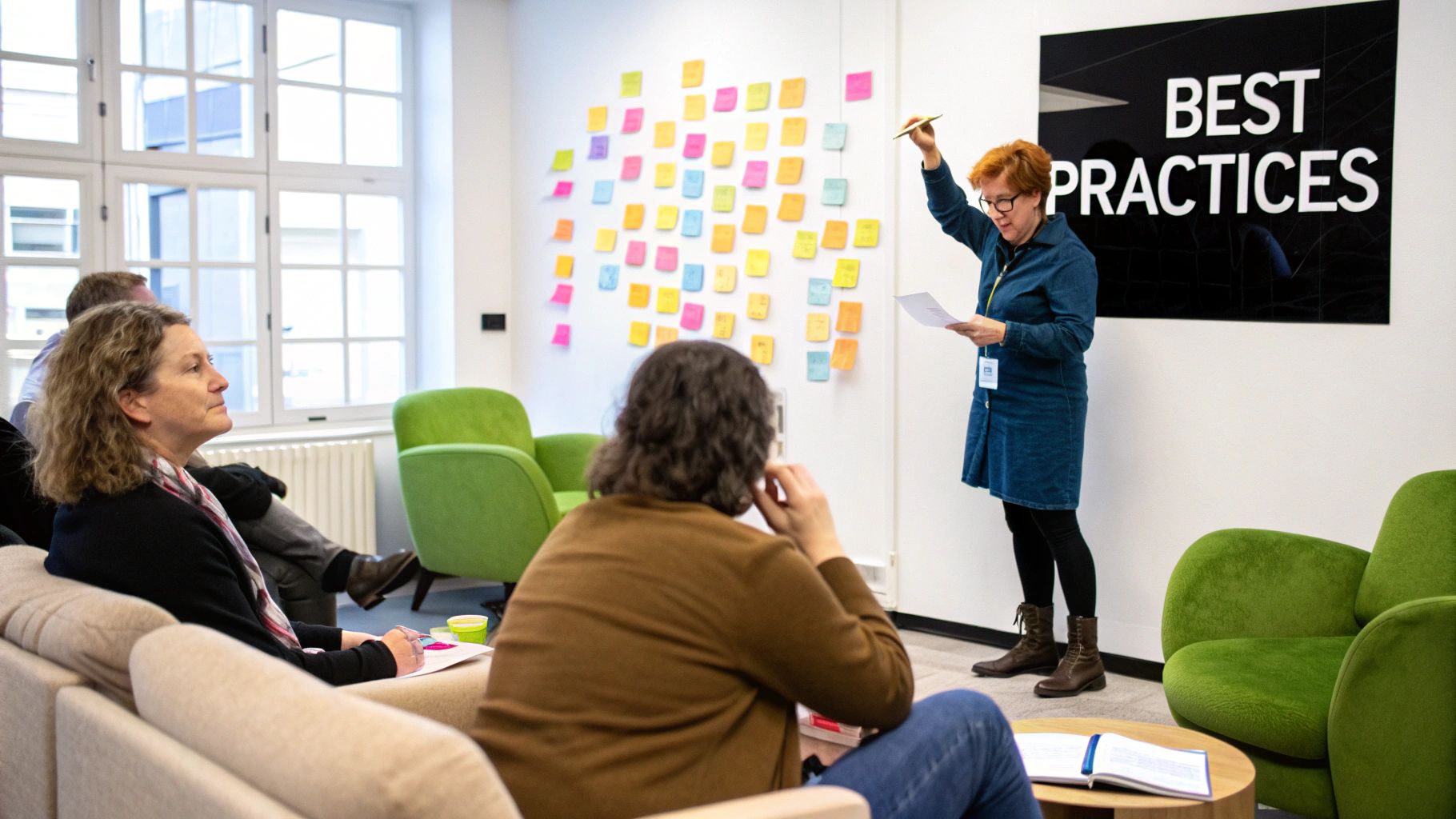The Strategic Value of Creative Operations Management

Creative operations management is more than simply managing projects. It's about fine-tuning the entire creative process. Think of it as the driving force behind efficiency, collaboration, and ultimately, exceptional creative output. By streamlining workflows and centralizing resources, businesses can significantly boost their creative impact.
Transforming From Tactical to Strategic
Creative operations was traditionally seen as a purely tactical function, mainly focused on project execution. This view has changed significantly. Today, creative operations management is a strategic differentiator, impacting everything from maintaining brand consistency to improving bottom-line results.
For instance, a well-structured creative operations system can drastically reduce time-to-market for new campaigns. This allows creative teams to concentrate on developing fresh ideas and driving innovation.
Bridging the Gap Between Vision and Outcomes
A key benefit of creative operations is its ability to link creative vision with measurable business outcomes. This connection is established by implementing frameworks that align creative endeavors with strategic goals.
Robust creative operations also ensure efficient resource allocation, minimizing waste and maximizing ROI. You might be interested in: How to master sitemaps.
Identifying Pain Points and Driving Efficiency
Effective creative operations management begins with a comprehensive understanding of the existing creative ecosystem. This includes identifying bottlenecks, redundancies, and other obstacles that hinder productivity.
In recent years, fragmented workflows and outdated tools have posed significant challenges. This inefficiency can result in substantial financial losses for brands due to campaign delays, underutilized assets, and missed rights renewals—all of which put a strain on marketing budgets. Explore this topic further.
The current economic climate demands efficiency and agility. It’s vital for marketers to centralize and streamline their creative workflows. Addressing these challenges can unlock substantial efficiency gains, resulting in quicker turnaround times and increased output.
Building Scalable Systems Without Sacrificing Quality
As businesses expand, so do their creative needs. Creative operations management provides the framework for scaling creative processes without sacrificing quality or brand consistency. This involves establishing standardized workflows, implementing robust quality control measures, and fostering a culture of continuous improvement.
This ensures consistently high-quality output, even as the volume of creative work increases. This strategic approach to creative operations empowers organizations to achieve both efficiency and creative excellence, ultimately driving business growth and success.
Creative Operations Leadership: Beyond Process Management
Creative operations management has evolved significantly. Today's leaders aren't simply managing workflows; they're strategic partners driving substantial business value. This requires navigating the intricate details of the creative process while ensuring alignment with overarching business objectives. It's a delicate balance between nurturing creative freedom and maintaining operational rigor. This new landscape demands a broader skillset from leaders.
The Evolving Role of Creative Operations Leaders
Effective creative operations leaders excel in several key areas. They cultivate influence across different departments, acting as a liaison between creative teams and other stakeholders. They also demonstrate return on investment (ROI) to executives, justifying budget allocation for creative resources. Moreover, they expertly manage cross-functional stakeholders, ensuring everyone works towards shared goals. This involves overseeing complex projects and implementing necessary changes without hindering creative momentum. Effective project management, using tools like Asana, is crucial for seamless creative operations. For valuable project management strategies, particularly in video production, check out this resource on video production project management.
Tactical Frameworks for Success
Several tactical frameworks contribute to successful creative operations leadership. Resource allocation is paramount, ensuring the right talent and tools are available for every project. Team structure optimization involves designing efficient workflows and defining clear roles. This clarity minimizes confusion and boosts productivity. Finally, successful leaders position themselves as value creators, not just process managers. This fosters a collaborative environment where creativity flourishes.
Navigating the Challenges of Modern Creative Operations
The current creative operations landscape presents distinct challenges. The sheer volume of available tools can be overwhelming. Organizational shifts add another layer of complexity. As of 2025, Creative Operations leaders tackle these issues directly. Over 3,000 new MarTech platforms emerged in 2024 alone. Amidst this rapid evolution, leaders prioritize aligning their teams with broader business goals, driving continuous process improvements, and integrating technology like AI to enhance operations. Discover more about the evolving landscape and best practices in this article on managing creative operations in 2025.
Building a Strong Foundation for Creative Success
A strong team is the cornerstone of any successful creative operation. Attracting and retaining top talent is key, and resources like How to master job listings can be invaluable. This includes identifying and nurturing talent, providing ongoing training opportunities, and cultivating a supportive work environment. When team members feel valued and empowered, they're more likely to produce their best work. This ultimately leads to better results for the entire organization. By implementing these strategies and embracing a leadership approach that transcends basic process management, creative operations can truly become a strategic driver of business growth and innovation.
Technology That Transforms Creative Workflows

Creative operations management and technology go hand-in-hand. But it's not just about having the newest gadgets. It's about using technology strategically to improve how creative teams work. This starts with identifying challenges and finding the right solutions. Just like a house needs a blueprint, creative operations need a solid technology strategy.
Evaluating Tools and Integrating Platforms
Choosing the right tools is essential. Teams should compare different platforms and consider their unique requirements. For instance, if version control is a problem, a cloud-based asset management system like Canto might be the answer. Integrating different platforms is also important. Connecting project management software with creative tools can automate tasks like file sharing and feedback. This smooths out the workflow, letting creative teams focus on creating.
The Impact of AI and Asset Management
Technologies like Artificial Intelligence (AI) are changing creative production. AI can automate routine tasks, personalize content, and even create assets. This isn't about replacing human creativity; it's about making creatives more efficient. Better asset management also plays a key role, saving time and resources by encouraging content reuse. An organized digital asset library like Bynder makes it easy to find approved assets. This helps maintain consistency and avoids the use of outdated materials.
Collaborative Platforms and Creative Quality
Collaboration platforms are crucial for maintaining quality, especially for teams working remotely. Platforms like Asana help with real-time feedback, version control, and clear communication. Teams can work together seamlessly, no matter where they are, making sure everyone stays on the same page. The global need for centralized tools is reflected in the growth of the creative management platform market. The use of generative AI in creative industries is also rapidly increasing. The market is expected to reach $4.09 billion in 2025, a 32.8% increase from 2024. More statistics can be found here.
Building a Business Case and Managing Change
Investing in technology needs a clear business case. It's important to show the Return on Investment (ROI). This could mean highlighting how technology can reduce costs, improve turnaround times, and boost creative quality. Change management is just as vital. Introducing new tech needs planning and clear communication. Teams need to understand the advantages and be ready for the change. A smooth transition is key to maximizing the technology's impact.
The following table compares different creative operations technologies and their key features:
Creative Operations Technology Comparison: A comparison of different types of creative operations management platforms and their key features.
| Platform Type | Key Features | Best For | Implementation Complexity | Cost Range |
|---|---|---|---|---|
| Project Management (e.g., Asana, Monday.com) | Task management, collaboration, workflow automation | Teams of all sizes | Low to Medium | Varies based on user count and features |
| Digital Asset Management (e.g., Canto, Bynder) | Asset storage, organization, version control | Marketing and creative teams | Medium to High | Varies based on storage and user count |
| Creative Collaboration (e.g., InVision, Figma) | Design prototyping, feedback, version control | Designers and creative teams | Low to Medium | Varies based on user count and features |
| Marketing Resource Management (e.g., Aprimo) | Marketing planning, budgeting, campaign management | Marketing departments | High | Typically higher cost due to comprehensive features |
This table highlights how different platform types cater to various needs within creative operations. Choosing the right technology hinges on understanding these differences and aligning them with specific organizational requirements.
The data chart below illustrates the potential improvements from using technology in creative operations. It compares key metrics before and after adoption.
| Metric | Before Technology Adoption | After Technology Adoption |
|---|---|---|
| Project Completion Rate | 70% | 90% |
| Average Turnaround Time (Days) | 15 | 7 |
| Resource Utilization | 65% | 85% |
The data chart clearly shows improvements in project completion rates, turnaround time, and resource use. This demonstrates how the right technology can significantly boost performance in creative operations. For more on maximizing creative potential, check out Creativize.
Building Creative Processes That Actually Scale

Many creative processes struggle to handle increasing demands. This section explores how successful organizations develop workflows that maintain high-quality creative output while adapting to growth. Think of your creative process as a factory assembly line.
Each step must seamlessly transition to the next to maintain efficiency. Any hold-up can disrupt the entire operation.
Identifying and Eliminating Bottlenecks
The first step in building scalable creative processes is identifying bottlenecks. These are points in the workflow where progress slows or even stops, impacting the entire production timeline.
For example, a bottleneck might be a single approval stage holding up numerous projects. Addressing these critical points often involves implementing targeted improvements that streamline workflows without sacrificing creative quality.
This requires a deep understanding of the nuances of creative work and implementing solutions that respect those needs.
Mapping the Creative Journey and Establishing Clear Handoffs
Effective creative operations management requires mapping the entire creative journey. This means meticulously documenting each step, from the initial spark of an idea to final delivery.
This clear visualization helps identify dependencies and potential roadblocks. Additionally, establishing clear handoffs between specialized teams is crucial.
This clarity ensures smooth transitions and minimizes confusion, similar to a relay race where a successful handoff is critical for victory.
Standardized Frameworks and Innovation
Creating standardized frameworks is key to scaling creative operations. However, these frameworks shouldn't stifle innovation. They should provide a structure that empowers creativity, offering a solid foundation upon which creative teams can build.
This balance between consistency and flexibility is vital for long-term success. Defining clear roles within the framework further reduces confusion and empowers team members. File compression tools, like smarter file compression, can significantly improve creative operations management by streamlining file sharing and minimizing storage costs.
Implementing Effective Governance
Implementing governance in creative operations ensures quality and consistency. This doesn't mean creating unnecessary red tape. Instead, effective governance provides guidelines and quality control measures that maintain high standards without hindering the creative flow.
This might involve establishing review processes and feedback loops that help improve quality over time. For more information, you might find this resource helpful: How to master categories.
Balancing Consistency and Flexibility
Balancing consistency with flexibility is an ongoing challenge in creative operations. While standardized processes ensure efficiency, there must be space for creative exploration and experimentation.
This requires a nuanced approach that recognizes when to adhere to established procedures and when to allow for deviations that could lead to innovative breakthroughs. This balance empowers teams to adapt to evolving project needs and deliver consistently high-quality work.
This adaptable approach to creative operations is essential for navigating the dynamic nature of the creative field and maintaining a competitive edge.
Measuring What Matters in Creative Operations
Measuring the success of your creative operations takes more than just looking at basic productivity. It's about understanding which Key Performance Indicators (KPIs) truly show the impact of creative work on your business goals. This means shifting away from surface-level metrics and focusing on data that gives you actionable insights. Just like a compass guides a ship, the right metrics will steer your creative operations towards success.
Developing Meaningful KPIs
Effective KPIs connect how your team operates to real business results. This means identifying metrics that not only reflect how efficiently your creative teams work, but also how effectively their work contributes to your overall organizational goals.
For example, instead of simply tracking the number of projects completed, consider measuring the impact of those projects on lead generation or brand awareness. This change in focus provides a much clearer picture of the value your creative operations team brings. This also allows you to demonstrate the ROI of your creative investments to stakeholders, justifying budgets and showcasing the strategic value of creative work.
Establishing Benchmarks and Calculating ROI
Establishing benchmarks is crucial for measuring improvement over time. These benchmarks give you a starting point to compare current performance, helping you identify areas for adjustment.
Accurately calculating the ROI of your creative operations is also essential for demonstrating its value. This means considering both the costs of creative production and the revenue generated as a result. This data-driven approach provides a clear picture of the financial impact of your creative operations. Learn more in our article about how to find talent for creative operations management.
To help you better understand which metrics to track, we've compiled a table of essential KPIs for measuring the effectiveness of creative operations management.
Here’s a look at some key metrics you should consider:
Creative Operations Performance Metrics
Essential KPIs for measuring the effectiveness of creative operations management
| Metric Category | Specific KPIs | Measurement Method | Benchmark Range | Business Impact |
|---|---|---|---|---|
| Efficiency | Project Completion Rate | Number of completed projects / Total number of projects | 80-95% | Improved productivity and resource allocation |
| Efficiency | Resource Utilization | Actual hours worked / Total available hours | 70-85% | Optimized resource allocation and cost savings |
| Effectiveness | Brand Consistency | Brand audits and customer surveys | Consistent brand voice and visuals across all platforms | Strengthened brand identity and customer recognition |
| Effectiveness | Creative Quality | Customer feedback and expert reviews | High scores on quality surveys and positive reviews | Enhanced customer engagement and brand perception |
| Impact | Lead Generation | Number of leads generated from creative campaigns | Varies by industry and campaign | Increased sales opportunities and revenue growth |
| Impact | Brand Awareness | Social media engagement, website traffic, and media mentions | Increased reach and engagement | Improved brand visibility and market share |
This table provides a starting point for building your own KPI framework. Remember to tailor the specific metrics and benchmarks to your organization's unique goals and industry.
Building Actionable Dashboards
Data visualization is key to understanding performance. Building dashboards that present key metrics clearly and concisely is vital. These dashboards should provide actionable insights, allowing creative operations leaders to identify trends, spot potential issues, and make informed decisions.
This means moving beyond simply reporting numbers and focusing on presenting data in a way that makes strategic decision-making easier. Dashboards should highlight both efficiency gains (like improved throughput and turnaround time) and effectiveness indicators (like creative quality and brand consistency).
Measuring Efficiency and Effectiveness
Measuring the success of creative operations involves a dual focus: efficiency and effectiveness. Efficiency metrics track how quickly and cost-effectively creative teams produce work, considering factors like project completion rates and resource utilization.
However, efficiency alone isn't the whole picture. Effectiveness measures assess the quality and impact of creative work. This might involve analyzing customer feedback on campaigns, measuring engagement rates on social media content, or tracking the conversion rates of marketing materials. This holistic approach provides a balanced view of creative operations performance.
Communicating Findings to Stakeholders
Effectively communicating performance data to stakeholders is crucial for securing buy-in and demonstrating the value of creative operations. This means presenting findings in a compelling and easy-to-understand way, using clear visuals and avoiding technical jargon.
Framing data within the context of business objectives helps stakeholders understand the impact of creative operations on the organization's bottom line. This clear communication fosters transparency and builds confidence in the creative operations function. This also strengthens collaboration between creative teams and other departments, ensuring everyone is working towards shared goals. This collaborative approach maximizes the impact of creative work and contributes to overall business success.
Bridging the Creative-Operations Divide

The relationship between creative teams and operations can sometimes feel strained. Creative teams often focus on innovation and flexibility, while operations prioritizes efficiency and structure. This inherent tension can hinder both. This section explores how successful organizations are creating cultures where these two seemingly opposing forces collaborate effectively.
Building a Shared Language and Mutual Respect
A key to bridging this divide is establishing a shared understanding. This begins with developing a common language for discussing projects, goals, and challenges. Clear communication helps reduce misunderstandings.
For example, clearly defining terms like "revision" or "deadline" ensures everyone is aligned. Fostering mutual respect between teams is also essential. Recognizing and valuing each other's contributions builds a strong foundation for productive teamwork. This environment allows both creative vision and operational efficiency to thrive.
Collaborative Processes and Team Structures
Collaborative processes are essential. This means involving both creative and operations teams in developing workflows and making decisions. When both sides contribute, the resulting processes are more likely to meet everyone's needs. This approach supports both creative exploration and efficient execution.
Well-defined team structures also play a vital role. Cross-functional teams, with members from both creative and operations, can foster greater understanding and collaboration. This structure promotes shared project ownership and breaks down traditional silos, ensuring creative work is both innovative and operationally sound.
Leadership Practices and Conflict Resolution
Leadership practices that balance competing priorities are critical. Leaders must understand and appreciate the unique needs of both creative and operations teams. This balanced perspective helps leaders make informed decisions that support creative freedom and operational discipline.
Effective conflict resolution is also vital. Disagreements are unavoidable, but they can be productive. Establishing clear communication channels and fostering open dialogue are key. Addressing conflicts constructively strengthens relationships between teams and can lead to better solutions.
Aligning Incentives and Feedback Loops
Aligning incentives across teams is important. Reward systems should recognize contributions from both creative and operations. This shared incentive structure encourages collaboration and minimizes potential conflict.
Feedback loops are crucial for continuous improvement. Regularly soliciting feedback from both teams and using that input to refine processes and improve collaboration keeps the creative-operations partnership strong and adaptable. For more insights on building successful creative operations, explore the resources available on Creativize. This platform offers a wealth of information and tools for creative professionals and businesses.
The Future of Creative Operations Excellence
Creative operations management is no longer simply about keeping projects on time and within budget. It's become a strategic function, vital for navigating the complexities of today's creative world. This shift is driven by several factors reshaping creative production, including the rise of distributed teams, evolving consumer expectations, and the integration of new technologies. Organizations that are looking ahead are already adapting to these changes, preparing for a future where creative operations plays a more central role.
The Rise of Distributed Talent and Evolving Consumer Expectations
The rise of remote work has opened up a global talent pool, allowing companies to access specialized skills worldwide. However, managing distributed teams presents new challenges for creative operations. Effective communication, collaboration tools like Slack, and streamlined workflows are essential for maintaining productivity and creative quality across different locations.
Consumer expectations are also changing rapidly. Today's audiences want personalized experiences, engaging content, and instant access across many platforms. Creative operations must adapt to these demands, ensuring creative teams deliver the right content, to the right audience, at the right time. This requires agility, flexibility, and a deep understanding of consumers' changing digital habits.
Technological Innovations Reshaping Creative Production
Technology continues to reshape creative operations. Artificial intelligence (AI), machine learning, and automation are transforming various aspects of creative production, from content creation and digital asset management to project management and workflow optimization. These technologies offer the potential to significantly improve efficiency, reduce costs, and improve creative output. However, they also require creative operations teams to learn new skills and adapt existing processes.
Reimagining Team Structures and Skillsets
Forward-thinking organizations are preparing for these shifts by reimagining team structures and developing new skills. This includes creating dedicated creative operations roles, implementing cross-functional collaboration models, and investing in training to equip team members with necessary skills for a technology-driven environment. Read also: How to structure your site.
The skills needed for creative operations excellence are evolving as well. Data analysis, strategic thinking, and technological proficiency are becoming increasingly important. Creative operations professionals who can analyze data, identify trends, and make data-driven decisions will be essential for maximizing creative impact and demonstrating ROI to stakeholders.
Data-Driven Decision Making and New Operational Models
Data is playing a bigger role in creative development. Creative operations teams are using data analytics to measure campaign effectiveness, track performance metrics, and understand consumer behavior. This data-driven approach allows them to optimize creative workflows, refine strategies, and make informed decisions that align with business goals.
New operational models are appearing that prioritize agility, collaboration, and data transparency. These models focus on flexible workflows, iterative processes, and real-time feedback to ensure creative teams can respond quickly to market demands and deliver high-quality work efficiently. These models also prioritize collaboration between creative and operational teams, breaking down traditional barriers and encouraging shared responsibility.
Future-Proofing Your Creative Operations Function
Organizations can take practical steps to future-proof their creative operations:
- Invest in technology: Adopt tools that streamline workflows, automate repetitive tasks, and enhance collaboration.
- Develop data literacy: Train creative operations professionals to analyze data, interpret insights, and make informed decisions.
- Embrace agile methodologies: Implement flexible workflows and iterative processes that allow quick adaptation to changing market conditions.
- Foster a culture of collaboration: Break down barriers between creative and operational teams, promoting shared understanding and mutual respect.
- Prioritize continuous learning: Encourage ongoing professional development to stay current with the evolving creative landscape.
By taking these steps, organizations can ensure their creative operations function is prepared for future challenges and opportunities, driving creative excellence and achieving measurable business results. Discover how Creativize can help you find the right talent to transform your creative operations: Visit Creativize.

